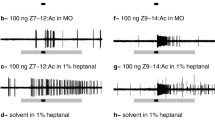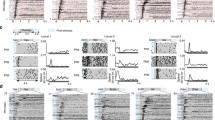Abstract
An often cited advantage of neuromorphic systems is their robust behavior in the face of operating variability, such as sensor noise and non-stationary stimuli statistics inherent to naturally variable environmental processes. One of the most challenging examples of this is extracting information from advected chemical plumes, which are governed by naturally turbulent unsteady flow, one of the very few remaining macroscopic physical phenomena that cannot be described using deterministic Newtonian mechanics. We describe a “synthetic moth” robotic platform that incorporates a real-time neuromorphic model of early olfactory processing in the moth brain (the macro-glomerular complex) for extracting ratiometric information from chemical plumes. Separate analysis has shown that our neuromorphic model achieves rapid and efficient classification of ratiometrically encoded chemical blends by exploiting early phase chemosensor array transients, with execution times well beyond biological timescales. Here, we test our neuromorphic synthetic moth in a naturally turbulent chemical plume and demonstrate robust ratiometric communication of infochemical information.
Access this chapter
Tax calculation will be finalised at checkout
Purchases are for personal use only
Preview
Unable to display preview. Download preview PDF.
Similar content being viewed by others
References
Wyatt, T.D.: Pheromones and Animal Behaviour, pp. 1–408. Cambridge University Press (2003)
Vickers, N.J., Baker, T.C.: Reiterative responses to single strands of odor promote sustained upwind flight and odor source location by moths. Proc. Natl. Acad. Sci. USA 91, 5756–5760 (1994)
Vickers, N.J., Christensen, T.A.: Functional divergence of spatially conserved olfactory glomeruli in two related moth species. Chem. Senses 28, 325–338 (2003)
Mustaparta, H.: Central mechanisms of pheromone information processing. Chem. Senses 21, 269–275 (1996)
Rácz, Z., Cole, M., Gardner, J.W., Chowdhury, M.F., Bula, W.P., Gardeniers, J.G.E., Karout, S., Capurro, A., Pearce, T.C.: Design and Implementation of a Modular Biomimetic Infochemical Communication System. Int. J. Circ. Theor. Appl. (2012), doi:10.1002/cta.1829
Rácz, Z., Olsson, S., Gardner, J., Pearce, T.C., Hansson, B., Cole, M.: Challenges of Biomimetic Infochemical Communication. Proc. Comp. Sci. 7, 106–109 (2011)
Cole, M., Gardner, J.W., Racz, Z., Pathak, S., Guerrero, A., Munoz, L., Carot, G., Pearce, T.C., Challiss, J., Markovic, D., Hansson, B.S., Olsson, S., Kubler, L., Gardeniers, J.G.E., Dimov, N., Bula, W.: Biomimetic Insect Infochemical Communication System. In: Proceedings 8th IEEE Conference on Sensors, pp. 1–5 (2009)
Cole, M., Gardner, J.W., Pathak, S., Pearce, T.C., Racz, Z.: Towards a biosynthetic infochemical communication system. In: Proceedings of the Eurosensors XXIII Conference, pp. 1–4 (2009)
Hansson, B.S., Ljungberg, H., Hallberg, E., Löfstedt, C.: Functional specialization of olfactory glomeruli in a moth. Science 256, 1313–1315 (1992)
Carlsson, M.A., Hansson, B.S.: Responses in highly selective sensory neurons to blends of pheromone components in the moth Agrotis segetum. J. Insect Physiol. 48, 443–451
Hansson, B.S., Anton, S.: Function and morphology of the antennal lobe: New developments. Annu. Rev. Entomol. 45, 203–231 (2000, 2002)
Akers, R.P., O’Connell, R.J.: Response specificity of male olfactory receptor neurons for the major and minor components of a female pheromone blend. Physiol. Entomol. 16, 1–17 (1991)
Sun, X.J., Tolbert, L.P., Hildebrand, J.G.: Synaptic organization of the uniglomerular projection neurons of the antennal lobe of the moth Manduca sexta: A laser scanning confocal and electron microscopic study. J. Comp. Neurol. 379, 2–20 (1997)
Carlsson, M.A., Galizia, C.G., Hansson, B.S.: Spatial representation of odours in the antennal lobe of the moth Spodoptera littoralis (Lepidoptera: Noctuidae). Chem. Senses 27, 231–244 (2002)
Chong, K.Y., Capurro, A., Karout, S., Pearce, T.C.: Stimulus and network dynamics collide in a ratiometric model of the antennal lobe macroglomerular complex. PLoS ONE 7, e29602–117 (2012), doi:10.1371/journal.pone.0029602
Guerrero-Rivera, R., Morrison, A., Diesmann, M., Pearce, T.C.: Programmable logic construction kits for hyper-real-time neuronal modeling. Neural Comput. 18, 2651–2679 (2006)
Yang, J., Rácz, Z., Gardner, J.W., Cole, M., Chen, H.: Ratiometric info-chemical communication system based on polymer-coated surface acoustic wave microsensors. Sensors Actuators B 173, 547–554 (2012)
Pearce, T.C., Gu, J., Chanie, E.: Chemical Source Classification in Naturally Turbulent Plumes. Analytical Chemistry 79(22), 8511–8519 (2007)
Marco, S., Gutierrez-Gálvez, A.: Recent developments in the application of biologically inspired computation to chemical sensing. In: AIP Conference Proceedings, vol. 1137, p. 151 (2009)
Huerta, R., Nowotny, T.: Bio-inspired solutions to the challenges of chemical sensing. Front. Neuroeng. 5, 24 (2012), doi:10.3389/fneng.2012.00024
Author information
Authors and Affiliations
Editor information
Editors and Affiliations
Rights and permissions
Copyright information
© 2013 Springer-Verlag Berlin Heidelberg
About this paper
Cite this paper
Pearce, T.C., Karout, S., Capurro, A., Rácz, Z., Cole, M., Gardner, J.W. (2013). Robust Ratiometric Infochemical Communication in a Neuromorphic “Synthetic Moth”. In: Lepora, N.F., Mura, A., Krapp, H.G., Verschure, P.F.M.J., Prescott, T.J. (eds) Biomimetic and Biohybrid Systems. Living Machines 2013. Lecture Notes in Computer Science(), vol 8064. Springer, Berlin, Heidelberg. https://doi.org/10.1007/978-3-642-39802-5_18
Download citation
DOI: https://doi.org/10.1007/978-3-642-39802-5_18
Publisher Name: Springer, Berlin, Heidelberg
Print ISBN: 978-3-642-39801-8
Online ISBN: 978-3-642-39802-5
eBook Packages: Computer ScienceComputer Science (R0)




